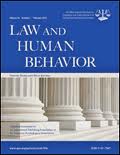
Criminal stereotypes are a potential source of bias in forensic evidence analysis and suggest that suspects who fit criminal stereotypes may be disadvantaged over the course of the criminal justice process. This is the bottom line of a recently published article in Law and Human Behavior. Below is a summary of the research and findings as well as a translation of this research into practice.

Featured Article | Law and Human Behavior | 2016, Vol. 40, No. 4, 420-429
The Perfect Match: Do Criminal Stereotypes Bias Forensic Evidence Analysis?
Author
Laura Smalarz, Williams College
Stephanie Madon, Iowa State University
Yueran Yang, Iowa State University
Max Guyll, Iowa State University
Sarah Buck, Southern Illinois University Carbondale
Abstract
This research provided the first empirical test of the hypothesis that stereotypes bias evaluations of forensic evidence. A pilot study (N 107) assessed the content and consensus of 20 criminal stereotypes by identifying perpetrator characteristics (e.g., sex, race, age, religion) that are stereotypically associated with specific crimes. In the main experiment (N 225), participants read a mock police incident report involving either a stereotyped crime (child molestation) or a nonstereotyped crime (identity theft) and judged whether a suspect’s fingerprint matched a fingerprint recovered at the crime scene. Accompanying the suspect’s fingerprint was personal information about the suspect of the type that is routinely available to fingerprint analysts (e.g., race, sex) and which could activate a stereotype. Participants most often perceived the fingerprints to match when the suspect fit the criminal stereotype, even though the prints did not actually match. Moreover, participants appeared to be unaware of the extent to which a criminal stereotype had biased their evaluations. These findings demonstrate that criminal stereotypes are a potential source of bias in forensic evidence analysis and suggest that suspects who fit criminal stereotypes may be disadvantaged over the course of the criminal justice process.
Keywords
forensic analysis, fingerprint evidence, stereotypes, forensic confirmation bias, contextual bias
Summary of the Research
“The National Academy of Sciences raised concerns regarding the extent to which the forensic sciences ‘rely on human interpretation that could be tainted by error.’ Corroborating these concerns, empirical studies have shown that contextual information—for example, that the suspect confessed or that eyewitnesses incriminated the suspect influence evaluations of forensic evidence. Although these findings are troubling, we believe that the potential for contextual information to bias forensic judgments may be more ubiquitous than these findings suggest. Whereas incriminating contextual information (e.g., that the suspect confessed) may be present in only a subset of cases, stereotypes are a pervasive feature of human social cognition, and more than 100 years of research has demonstrated that stereotypes bias judgments and alter behavior” (p. 420).
“The main experiment provided an initial test of the hypothesis that criminal stereotypes bias evaluations of forensic evidence. Two crimes were selected for use in the main experiment on the basis of our findings from the pilot study: one crime that was strongly associated with particular perpetrator characteristics (stereotyped crime) and one crime that was not strongly associated with particular perpetrator characteristics (nonstereotyped crime). We selected child molestation as the stereotyped crime for two reasons. First, child molestation was identified as a crime that is associated with a highly consensual criminal stereotype. Second, the perpetrator characteristics comprising the criminal stereotype for the crime of child molestation were ethnicity (White) and sex (male)—two characteristics that are likely to appear in fingerprint. Although there were other criminal stereotypes that were also highly consensual—for example, prostitution and purse snatching—we elected not to use them because they were associated with perpetrator characteristics that would not likely be available to forensic examiners (e.g., education level and employment status). We selected the crime of identity theft as the nonstereotyped crime because both our pilot study as well as past research indicate that it is not strongly associated with any particular perpetrator characteristics” (p. 424).
“In the main experiment, we varied the characteristics of the criminal suspect such that the suspect’s characteristics were either consistent with the child molestation stereotype (White man) or inconsistent with the child molestation stereotype (Asian woman). Hence, participants were randomly assigned to a 2 (crime type: child molestation v. identity theft) x 2 (suspect characteristics: White man v. Asian woman) between-subjects factorial design. We predicted that the suspect’s characteristics would bias evaluations of forensic evidence for the crime of child molestation, which is strongly associated with White male perpetrators, but not for the crime of identity theft, which is not associated with particular perpetrator characteristics” (p. 424).
“This experiment demonstrated for the first time that criminal stereotypes can bias evaluations of forensic evidence. Participants were more likely to incorrectly judge two fingerprints as a match when the suspect fit a criminal stereotype than when the suspect did not fit a criminal stereotype. For the crime of identity theft, which is not strongly associated with a criminal stereotype, the suspect’s characteristics did not affect participants’ match judgments. Indeed, the majority of participants in the identity theft condition correctly judged the fingerprints as a non-match regardless of whether the suspect was a White man or an Asian woman. But for the crime of child molestation, which has strong stereotypic associations with White male perpetrators, the suspect’s characteristics strongly influenced participants’ judgments. Participants were nearly twice as likely to indicate that the prints matched in the child molestation case when the suspect was a White man as opposed to an Asian woman” (p. 426).
Translating Research into Practice
“Research on bias correction suggests that people often hold inaccurate beliefs about how their biases influence their behavior. These well-established psychological principles converge with the current research findings to suggest that simply asking forensic examiners whether their judgments were influenced by a criminal stereotype is an insufficient method of assessing bias” (p. 426).
“This research lends support to recent calls for reform in the domain of forensic evidence analysis. Potential remedies have been proposed to help combat the effects of contextual biases on forensic examiners’ judgments. For example, linear sequential unmasking is a method in which analysts are shielded from all task-irrelevant information and are exposed to potentially biasing task-relevant information as late in the examination process as possible and only when absolutely necessary. Another potential remedy to combat the effects of contextual biases is the filler-control method, in which the suspect’s sample is presented along with other ‘filler’ samples that are known to be unassociated with the crime. Because the forensic analyst does not know which sample is from the suspect and which samples are fillers, the filler-control method neutralizes the effects of potentially biasing contextual information. Moreover, the filler-control method has the unique advantage of providing an estimate of error rates and thus can quickly expose fraudulent analysts and invalid forensic techniques” (p. 427).
Other Interesting Tidbits for Researchers and Clinicians
“An interesting question raised by these findings is whether differences in the perceived severity of the crimes of child molestation and identity theft may have influenced participants’ match judgments. We elected to use these two crimes because of their strong and weak associations with a criminal stereotype, respectively, however, it may have also been the case that differences in the perceived severity of the crimes influenced participants’ reliance on a criminal stereotype to inform their match judgments. Such a phenomenon would raise the possibility that the effects observed in the current research may be even more pronounced in real-world cases involving severe crimes. Future research should examine whether crime severity moderates the extent to which criminal stereotypes bias evaluations of forensic evidence” (p. 426).
Join the Discussion
As always, please join the discussion below if you have thoughts or comments to add!





















